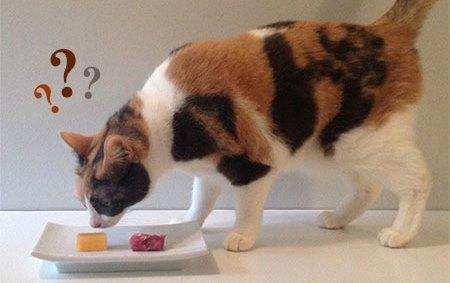This content is archived from the Feline Nutrition Foundation
Cats and Cantaloupe: A Method to their Madness
- Updated: Monday, May 20, 2019 04:24 PM
- Published: Sunday, November 02, 2014 05:24 PM
- Written by Margaret Gates
 One of the things we hear about all the time is the strange things cats will eat. If you've had cats for any length of time, you've experienced this. Not just the odd items in the meat category, such as grasshoppers or frogs, but also things like broccoli and string beans. The one food item that seems to come up time and again is cantaloupe. Having a cat that wants to eat something unusual now and then doesn't seem implausible. They are individuals subject to the variations in behavior that entails.
One of the things we hear about all the time is the strange things cats will eat. If you've had cats for any length of time, you've experienced this. Not just the odd items in the meat category, such as grasshoppers or frogs, but also things like broccoli and string beans. The one food item that seems to come up time and again is cantaloupe. Having a cat that wants to eat something unusual now and then doesn't seem implausible. They are individuals subject to the variations in behavior that entails.
But to have cats from all different parts of the world, in the past and the present, seemingly unable to resist cantaloupe, has to be more than just coincidence. Something's going on.
Being naturally curious – okay, I confess, maybe irrationally curious – I decided to investigate what's up with cantaloupe. When I looked around, there's lots of speculation having to do with the texture, taste or moisture. I remember as a kid, we had a cantaloupe-obsessed cat. She was not allowed on the dining table. In fact, she never jumped on it, ever. Well, one day we walked into the room and found her on the dining table, happily eating all of the cantaloupe out of a fruit salad. Aha. To know it was there, she must have smelled it. Aroma is the key.
 This leads us to volatiles, substances that vaporize readily. They are what foods give off that we then smell. Something about the smell of cantaloupe makes cats want to eat it. This is bizarre, as cats are obligate carnivores. They would normally have no interest in such food. Even the makers of dry cat foods know this. Kibble foods are sprayed with aromatic concoctions called "digests" to make them appealing to cats, who would otherwise ignore these carbohydrate-laden products.
This leads us to volatiles, substances that vaporize readily. They are what foods give off that we then smell. Something about the smell of cantaloupe makes cats want to eat it. This is bizarre, as cats are obligate carnivores. They would normally have no interest in such food. Even the makers of dry cat foods know this. Kibble foods are sprayed with aromatic concoctions called "digests" to make them appealing to cats, who would otherwise ignore these carbohydrate-laden products.
"Volatiles derived from amino acids are major contributors to melon aroma."¹ This sentence from a research study on melon volatiles may hold the key to why so many cats love cantaloupe. To them, it smells like meat. Amino acids are the building blocks of protein. Meat is made up of them. Many of the same amino acids in meat are present in melons, although in much smaller quantities.² We don't know exactly what meat smells like to a cat, but they're hard-wired to be attracted to it. It makes sense they would be highly sensitive to all the compounds in meat. The presence of the same volatiles in other foods would naturally interest them.
Additional Reading
Answers: Plant vs. Meat – The Protein Feud for Cat Food
Answers: What Dry Food Does to Your Cat's Fur
So, it looks like kibble producers aren't the only ones who are tricking cats into eating inappropriate foods. Mother Nature is doing it, too. If you have a cantaloupe-crazed feline, don't worry, she can have a little bit on occasion. Just limit the amount to a bite or two to prevent any gastrointestinal upset. Your cat's intense interest in it proves a point, though. What cats want and need – and what they instinctively seek out – is meat.
Margaret Gates is the founder of the Feline Nutrition Foundation.
1. I Gonda, E Bar, V Portnoy, S Lev, J Burger, AA Schaffer, Y Tadmor, S Gepstein, JJ Giovannoni, N Katzir and E Lewinsohn, "Branched-chain and Aromatic Amino Acid Catabolism into Aroma Volatiles in Cucumis Melo L. Fruit," Journal of Experimental Botany 61, No. 4, March 2010, 1111-1123.
2. S Lignou, JK Parker, C Baxter and DS Mottrama, "Sensory and Instrumental Analysis of Medium and Long Shelf-life Charentais Cantaloupe Melons (Cucumis melo L.) Harvested at Different Maturities," Food Chemistry 148, No. 100, Apr 1, 2014, 218-229.




